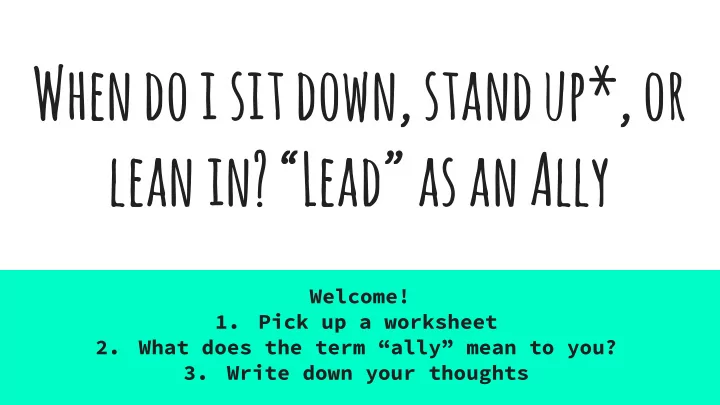

When do i sit down, stand up*, or lean in? “Lead” as an Ally Welcome! 1. Pick up a worksheet 2. What does the term “ally” mean to you? 3. Write down your thoughts
Wendy Ng Manager, Learning Royal Ontario Museum Toronto, Canada wendyn@rom.on.ca @twin_muses Pronoun: She/Her Photo: Terence Wallis @indelibleadventures
Alyssa Greenberg Doctoral Candidate Department of Art History, University of Illinois at Chicago cHICAGO, ILLINOIS Alyssa.Greenberg@gmail.com @GreenbergAlyssa Pronoun: She/Her
Keonna Hendrick Cultural Strategist/Independent consultant @ Keonna Hendrick Teen Reviewers and Critics (TRaC) Program Manager @ ArtsConnection New York City, New York KeonnaHendrick@gmail.com @KeonnaHendrick Pronoun: She/Her
Syrus Marcus Ware Contact: Program Coordinator, Youth Programs @syrusmarcusware Art Gallery of Ontario, Toronto, Canada syrusmarcusware@gmail.com Doctoral Candidate, FES, York University Pronoun: He/Him
What does the term 1. Turn to your neighbour “Ally” mean to you? 2. Share your thoughts
An Ally...
Create spaces and ● opportunities for marginalized identities in personnel, programs, Understands “It’s and exhibitions Pause and listen! Do ● not about you” not monopolize these spaces and opportunities Be humble, admit ● mistakes, and learn from them
Practices active Listen intently with ● your full attention listening and self- Withhold judgement ● Check and address your ● implicit biases reflection Respond thoughtfully ●
Listen! ● Do your homework (Check Is always learning ● out resources) Seek out answers. Do ● not expect others to teach you.
Allyship is a Not applied only when ● it’s convenient conscious and Avoid tokenism ● There are no breaks! ● (Allies don’t retreat constant practice into their privilege).
Museums are inherently ● political As individuals, we are ● all political Guiding Principles Marginalized ● communities are not inherently lacking Diversity and inclusion ● are practices, not end points
Identity Markers How do you How do define yourself? others define you? Write down your thoughts
Identity Markers Example How do you How do define yourself? others define you? Heterosexual Black Black Strong-willed Funny Woman Woman Adult Politically minded Educated Middle class Chubby Passionate Opinionated Northern Female Educator Southern Cis Young Cis Not religious Funny Spiritual Vocal Bright Christian Democrat
Positionality How have your How have your identity markers identity markers provided privilege? created oppression? Write down your thoughts
Positionality Example How have your identity How have you created markers provided oppression Through privilege? Your identity markers ? As a cis person: As a cis person: ● I don’t have to think about whether ● I have held a narrow view of womanhood bathrooms will be safe for me to use; that is based on sex and fertility; ● People respect my personal gender ● I assume others’ personal gender pronouns pronouns without asking; ● No one questions if I’m a “real” woman; ● I’ve brushed off gender identities of trans ● When I express my gender identity, youth as exploratory; people don’t call me confused, unstable ● I have privileged the gender binary (i.e. or mentally ill. man/woman) over multiple gender identities.
1. Read scenario 2. Identify main issues/challenges. What is the offensive a. Scenarios: action in the scenario? In what ways might the b. action be offensive and What would you do? potentially oppressive to an individual or community? 3. How might you respond as an ally in this situation? Discuss, write, and/or role-play potential responses
Scenario #1 Two children--a black boy and an Asian girl--approach the costume area in the museum’s hands-on play space. The girl points to a medieval armor costume indicating she’d like to try it on. The museum volunteer overseeing the costumes says to her, “Armor is for boys. How about you try on the dress instead?”, and she proceeds to hand the armor to the boy. As the two children play, they begin to swing their toys around, disrupting other visitors. Another volunteer sees this happening, walks over to the boy, tells him to stop immediately, and walks away while the girl stands nearby.
Scenario #2 You receive an email from an undergraduate who wishes to inquire about the status of her summer internship application. She attaches her application to the message and you are impressed by her writing and interests. You ask your colleague if she received the application and why it was not shared with you. She explains that the museum should set higher standards by focusing on candidates from private colleges and universities who do not need second jobs and can devote more time to the internship.
Scenario #3 During a professional development workshop, a colleague models an activity she uses with elementary age children to discuss living in the United States in the early 1800s. She asks participants to look carefully at the painting and count the number of African Americans they see. When one participant notes that a woman in the painting might be African American, your colleague encourages the person to look closely and notice that the person may be too “fair” to be Black.
Scenario #4 You just finished teaching a lesson to a group of high school students and start telling them about afterschool programs that they can participate in if they are interested in art. One student says that he will have to ask his parents before he applies. Another boy turns to him and says, “That’s so gay man!” The other teens laugh. The teen who mentioned asking his parents brushes it off with laughter and tells the boy, “Shut up, man.”
Equity and Inclusion are the work of museums! Support from the top down ● Build inclusion into budgets ● Create a cross-departmental equity and inclusion ● committee Review and revise recruitment, hiring, and retention ● practices in human resources Develop training and accountability measures for all ● staff and volunteers Partner with community organizations doing social justice ● work, listen, and support
What is one take Write it down ● Tweet it ● #Allyship, away that you will ○ #AccomplicesNotAllies, #AllyshipChat #NAEAMusEd16, @NAEAMusEd apply to your work ○ #NAEA16, @NAEA ○ @twin_muses ○ @GreenbergAlyssa immediately? @KeonnaHendrick @SyrusMarcusWare
Recommend
More recommend